一、简介
这是一个简单小巧的C语言线程池实现,在 Github 上有 1.1K 的 star,很适合用来学习 Linux 的多线程编程。
另外,里面还涉及到了信号、队列、同步等知识点,代码读起来还是挺过瘾的。
特点:
- 符合 ANCI C and POSIX;
- 支持暂停/恢复/等待功能;
- 简洁的 API;
- 经过严格的测试,附带了丰富的测试用例;
二、使用
快速上手
example.c:
#include "thpool.h"
void task(void *arg){
printf("Thread #%u working on %d
", (int)pthread_self(), (int) arg);
}
int main(){
puts("Making threadpool with 4 threads");
threadpool thpool = thpool_init(4);
puts("Adding 10 tasks to threadpool");
int i;
for (i=0; i<8; i++){
thpool_add_work(thpool, task, (void*)(uintptr_t)i);
};
thpool_wait(thpool);
puts("Killing threadpool");
thpool_destroy(thpool);
return 0;
}
运行效果:
$ gcc example.c thpool.c -D THPOOL_DEBUG -pthread -o example
$ ./example
Making threadpool with 4 threads
THPOOL_DEBUG: Created thread 0 in pool
THPOOL_DEBUG: Created thread 1 in pool
THPOOL_DEBUG: Created thread 2 in pool
THPOOL_DEBUG: Created thread 3 in pool
Adding 10 tasks to threadpool
Thread #1509455616 working on 0
Thread #1509455616 working on 4
Thread #1509455616 working on 5
Thread #1492670208 working on 2
Thread #1492670208 working on 7
Thread #1509455616 working on 6
Thread #1501062912 working on 1
Thread #1517848320 working on 3
Killing threadpool
代码分析:
threadpool thpool = thpool_init(4)创建了一个含有 4 个线程的线程池;- 然后调用
thpool_add_work(thpool, ...)往线程池里放入了 8 个任务; - 从结果来看:
线程5616抢到了任务 0 / 4 / 5 / 6;线程0208抢到了任务 2 / 7;线程2919抢到了任务 1;线程8320抢到了任务 3;
API 简介
| 示例 | 作用 |
|---|---|
| thpool_init(4) | 创建一个含有 4 个线程的线程池。 |
| * thpool_add_work(thpool, (void)function_p, (void )arg_p)* ** | 添加任务, function_p 是任务要执行的函数,arg_p 是 function_p 的参数。 |
| thpool_wait(thpool) | 等待所有任务完成。 |
| thpool_destroy(thpool) | 销毁线程池,如果还有任务在执行,则会先等待其完成。 |
| thpool_pause(thpool) | 让所有的线程都停止工作,进入睡眠状态。 |
| thpool_resume(thpool) | 让所有的线程都恢复工作。 |
| thpool_num_threads_working(thpool) | 返回当前正在工作的线程数。 |
三、内部实现
整体把握
核心代码就是 2 个文件:thpool.c 和 thpool.h。
分解 thpool.c
7 个公共函数:
struct thpool_* thpool_init(int num_threads)
int thpool_add_work(thpool_* thpool_p, void (*function_p)(void*), void* arg_p)
void thpool_wait(thpool_* thpool_p)
void thpool_destroy(thpool_* thpool_p)
void thpool_pause(thpool_* thpool_p)
void thpool_resume(thpool_* thpool_p)
int thpool_num_threads_working(thpool_* thpool_p)
正好就是前面说过的 7 个 API,稍后重点分析。
5 个自定义的数据结构:
// 描述一个信号量
typedef struct bsem {...} bsem;
// 描述一个任务
typedef struct job {...} job;
// 描述一个任务队列
typedef struct jobqueue {...} jobqueue;
// 描述一个线程
typedef struct thread {...} thread;
// 描述一个线程池
typedef struct thpool_ {...} thpool_;
14 个私有函数:
// 构造 struct thread,并调用 pthread_create() 创建线程
static int thread_init (thpool_* thpool_p, struct thread** thread_p, int id)
// 当线程被暂停时会在这里休眠
static void thread_hold(int sig_id)
// 线程在此函数中执行任务
static void* thread_do(struct thread* thread_p)
// 销毁 struct thread
static void thread_destroy (thread* thread_p)
// 任务队列相关的操作集合
static int jobqueue_init(jobqueue* jobqueue_p)
static void jobqueue_clear(jobqueue* jobqueue_p)
static void jobqueue_push(jobqueue* jobqueue_p, struct job* newjob)
static struct job* jobqueue_pull(jobqueue* jobqueue_p)
static void jobqueue_destroy(jobqueue* jobqueue_p)
// 信号量相关的操作集合
static void bsem_init(bsem *bsem_p, int value)
static void bsem_reset(bsem *bsem_p)
static void bsem_post(bsem *bsem_p)
static void bsem_post_all(bsem *bsem_p)
static void bsem_wait(bsem* bsem_p)
核心 API 的实现
1. thpool_init()
该函数用于创建一个线程池,先明确线程池的定义:
typedef struct thpool_{
thread** threads; /* pointer to threads */
volatile int num_threads_alive; /* threads currently alive */
volatile int num_threads_working; /* threads currently working */
pthread_mutex_t thcount_lock; /* used for thread count etc */
pthread_cond_t threads_all_idle; /* signal to thpool_wait */
jobqueue jobqueue; /* job queue */
} thpool_;
thpool_init() 的实现思路:
- 分配 struct thpool_:
- malloc(sizeof(struct thpool_))
- 初始化 struct thpool_;
- malloc(num_threads * sizeof(struct thread *))
- thread_init(thpool_p, &thpool_p->threads[n], n);
- jobqueue_init(&thpool_p->jobqueue)
- 初始化 jobqueue:
- 创建用户指定数目的线程,用一个二级指针来指向这一组线程;
- 返回 struct thpool_ *;
2. thpool_add_work()
该函数用于往线程池里添加一个任务,先明确任务的定义:
typedef struct job{
struct job* prev; /* pointer to previous job */
void (*function)(void* arg); /* function pointer */
void* arg; /* function's argument */
} job;
程序里是用队列来管理任务的,这里的 job 首先是一个队列节点,携带的数据是 function + arg。
thpool_add_work 的实现思路:
- 分配 struct job:
- malloc(sizeof(struct job))
- 初始化 struct job;
- newjob->function=function_p;
- newjob->arg=arg_p;
- 添加到队列中:
- jobqueue_push(&thpool_p->jobqueue, newjob);
3. thpool_pause() 和 thpool_resume()
thpool_pause() 用于暂停所有的线程,通过信号机制来实现:
void thpool_pause(thpool_* thpool_p) {
int n;
for (n=0; n < thpool_p->num_threads_alive; n++){
pthread_kill(thpool_p->threads[n]->pthread, SIGUSR1);
}
}
给所有工作线程发送 SIGUSR1,该信号的处理行为就是让线程休眠:
static void thread_hold(int sig_id) {
(void)sig_id;
threads_on_hold = 1;
while (threads_on_hold){
sleep(1);
}
}
只需要 thpool_resume() 中,将 threads_on_hold = 0,就可以让线程返回到原来被中止时的工作状态。
4. thpool_wait()
wait 的实现比较简单,只要还有任务或者还有线程处于工作状态,就执行 pthread 的 wait 操作:
while (thpool_p->jobqueue.len || thpool_p->num_threads_working) {
pthread_cond_wait(&thpool_p->threads_all_idle, &thpool_p->thcount_lock);
}
到此,我感觉已经没有太多难点了,感兴趣的小伙伴们可以自行查阅源码。
四、测试用例
优秀的开源项目通常会附带丰富的测试用例,此项目也不例外:
- memleaks.sh:测试是否发生内存泄露;
- threadpool.sh: 测试线程池是否能正确地执行任务;
- pause_resume.sh:测试 pause 和 resume 是否正常;
- wait.sh:测试 wait 功能是否正常;
- heap_stack_garbage:测试堆栈内有垃圾数据时的情况;
-
Linux
+关注
关注
87文章
11310浏览量
209581 -
C语言
+关注
关注
180文章
7605浏览量
136889 -
线程池
+关注
关注
0文章
57浏览量
6851 -
线程
+关注
关注
0文章
505浏览量
19691 -
GitHub
+关注
关注
3文章
471浏览量
16457
发布评论请先 登录
相关推荐
跨平台的线程池组件--TP组件
Java中的线程池包括哪些
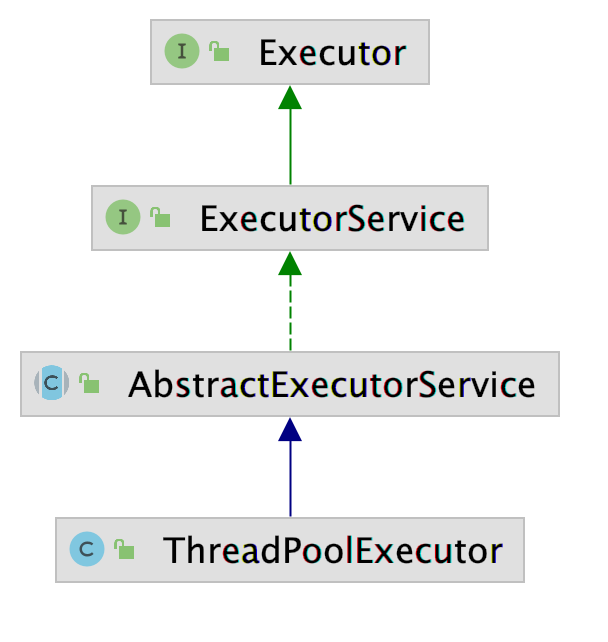
线程池的线程怎么释放

Spring 的线程池应用
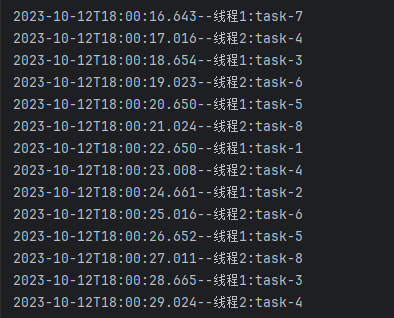




 C语言线程池的实现方案
C语言线程池的实现方案

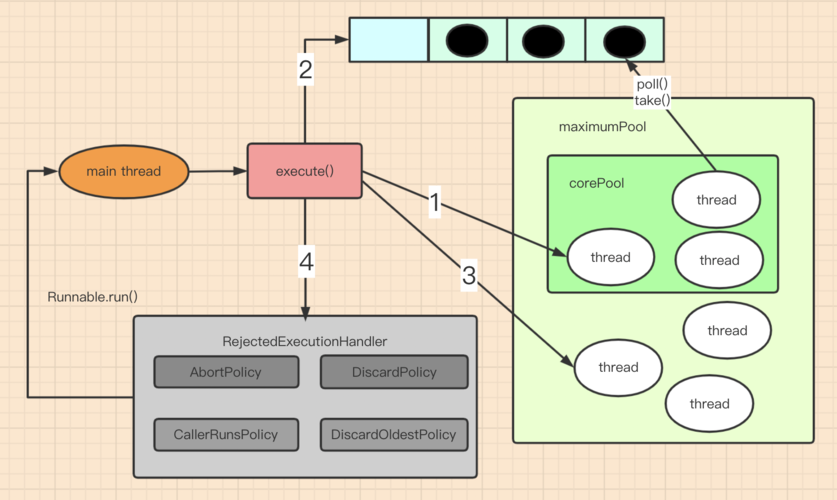

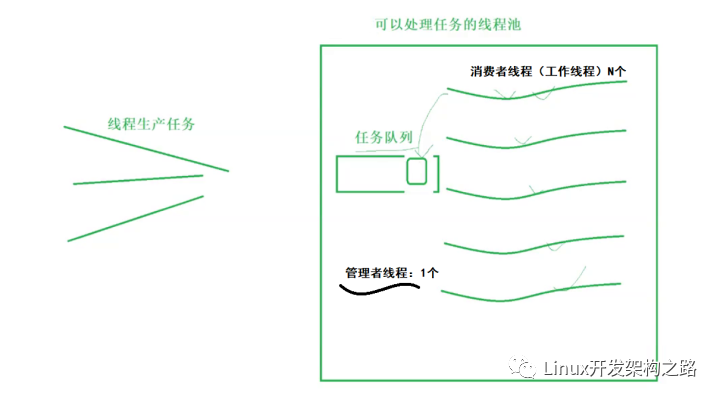
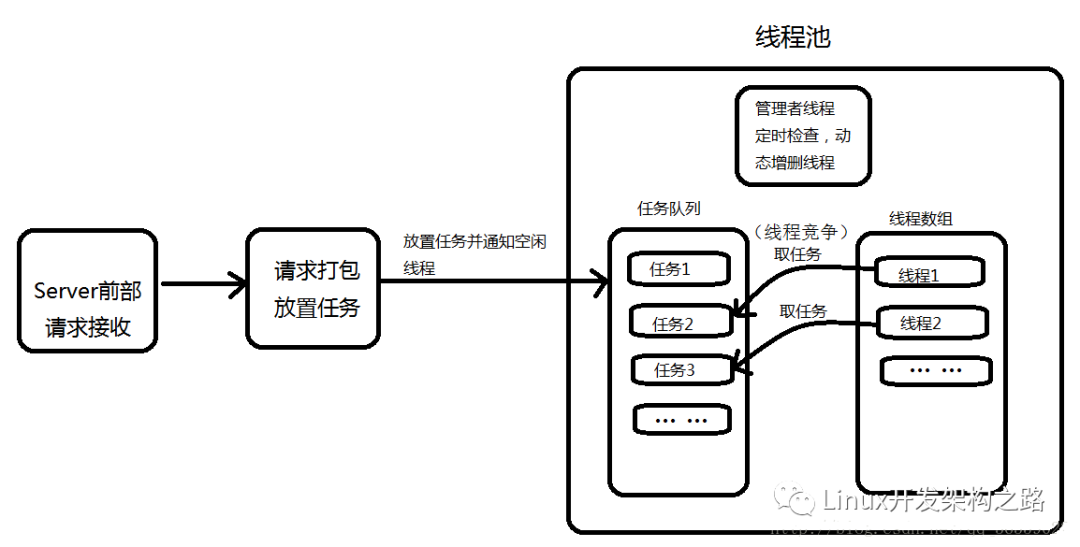










评论